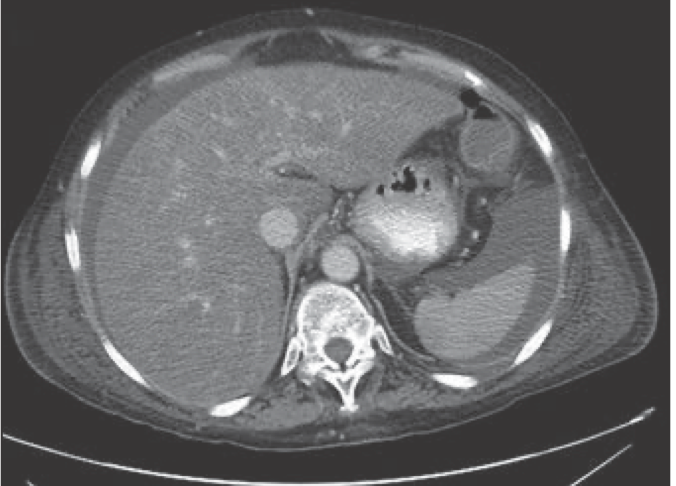Multi-Parametric CT Offers Earlier Detection for Common Liver Disease
CT can provide faster, easier-to-capture evidence of non-alcoholic fatty liver disease than MRI or ultrasound elastography.
Non-alcoholic fatty liver disease (NAFLD) is rapidly becoming the most common cause of liver disease worldwide, and multi-parametric CT can be an effective way for providers to identify which patients have the condition.
With NAFLD affecting roughly 25 percent of adults across the globe – and nearly a quarter of those individuals progressing on to non-alcoholic steatohepatitis (NASH), a precursor to cirrhosis – finding a strategy that can pinpoint patients who could benefit from treatment is critical.
In an article published Jan. 22 in the American College of Roentgenology, a team of investigators from the University of Wisconsin outlined the CT parameters that enable non-invasive NAFLD detection. They also presented their results during the American Roentgen Ray Society (ARRS) 2019 annual meeting.
Related Content: MRI Technique Can Estimate Liver Fat in Children
“CT is a highly accessible, frequently used method for assessment of patients with NAFLD and identification of those with high-risk NAFLD (advanced fibrosis or cirrhosis) who are potentially most in need of intervention,” said the team led by Meghan G. Lubner, M.D., professor of radiology in the abdominal imaging section at Wisconsin.
True-positive assessments in 58-year-old woman with high-risk nonalcoholic fatty liver disease (NAFLD) and associated NASH. CT images show hepatic enlargement, heterogeneously low-attenuation hepatic parenchyma, and surrounding ascites. Readers correctly identified NASH according to these imaging features. Readers also correctly identified fibrosis stage F3. Courtesy: American Journal of Roentgenology

True-positive assessments in 52-year-old man with high-risk nonalcoholic fatty liver disease (NAFLD) and associated NASH. CT images show hepatic enlargement, heterogeneously low-attenuation hepatic parenchyma, and surrounding ascites. Readers correctly identified NASH according to these imaging features. Readers also correctly identified fibrosis stage F3. Courtesy: American Journal of Roentgenology

The use of multi-parametric CT fills a void, the team said. Both MR and ultrasound elastography techniques has been successful in measuring liver stiffness as a surrogate for fibrosis. But, they come with obstacles – not only do they require a significant level of expertise, but they also are not used much in the clinical setting. In contrast, non-invasive CT biomarkers are frequently used clinically to diagnose liver disease and hepatic fibrosis.
For this study, Lubner’s team focused specifically on identifying patients with high-risk NAFLD. In a single-institution retrospective cohort study, they looked at CT images captured on 16-to-64-MDCT scanners within a year of liver biopsy from 186 patients with the condition. Most images were contrast-enhanced.
False-positive assessments in 73-year-old woman with high-risk NAFLD but without pathologic evidence of NASH. CT images show findings similar to A and B. Readers incorrectly identified NASH because of these imaging findings but correctly identified fibrosis stages F3. Courtesy: American Journal of Roentgenology

False-positive assessments in 61-year-old woman with high-risk NAFLD but without pathologic evidence of NASH. CT images show findings similar to A and B. Readers incorrectly identified NASH because of these imaging findings but correctly identified fibrosis stages F4. Courtesy: American Journal of Roentgenology

Of the group, 87 individuals had NASH, and 112 had moderate-to-severe steatosis. For fibrosis stages, 51 were F0, 42 were F1, 23 were F2, 37 were F3, and 33 were F4. A group of 70 individuals – 38 percent – had advanced fibrosis and high-risk NAFLD.
Based on the team’s analysis, the Fibrosis-4 (FIB-4) index score correlated with fibrosis with ROC AUC of 0.75 for identifying high-risk NAFLD. In addition, the CT parameters liver segmental volume ratio and splenic volume performed best – they both had an AUC of 0.69 for detection of the condition.
“Patients with a high FIB-4 score and CT findings of advanced fibrosis may no longer need biopsy for confirmation,” the team said. “Therefore, use of FIB-4 and CT together may reduce the need for invasive testing.”
Overall, however, they explained, reader assessment – a subjective cognitive combination of the measured features by trained readers – was the highest performing parameter with an AUC of 0.78 and 0.79 for both readers. Performance by the readers revealed a good association with the presence of advanced fibrosis.
While CT performed well for NAFLD detection, it was underwhelming for picking up on evidence of NASH. According to the team, all single imaging parameters, including subjective reader assessment, performed poorly.
For more coverage based on industry expert insights and research, subscribe to the Diagnostic Imaging e-Newsletter here.
Emerging AI Algorithm Shows Promise for Abbreviated Breast MRI in Multicenter Study
April 25th 2025An artificial intelligence algorithm for dynamic contrast-enhanced breast MRI offered a 93.9 percent AUC for breast cancer detection, and a 92.3 percent sensitivity in BI-RADS 3 cases, according to new research presented at the Society for Breast Imaging (SBI) conference.
Can Abbreviated Breast MRI Have an Impact in Assessing Post-Neoadjuvant Chemotherapy Response?
April 24th 2025New research presented at the Society for Breast Imaging (SBI) conference suggests that abbreviated MRI is comparable to full MRI in assessing pathologic complete response to neoadjuvant chemotherapy for breast cancer.
Clarius Mobile Health Unveils Anterior Knee Feature for Handheld Ultrasound
April 23rd 2025The T-Mode Anterior Knee feature reportedly offers a combination of automated segmentation and real-time conversion of grayscale ultrasound images into color-coded visuals that bolster understanding for novice ultrasound users.